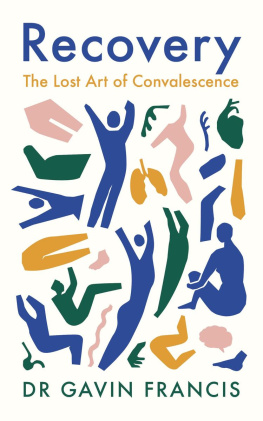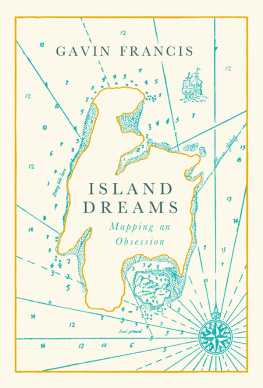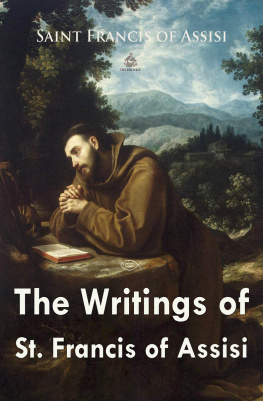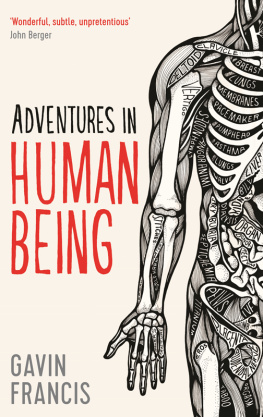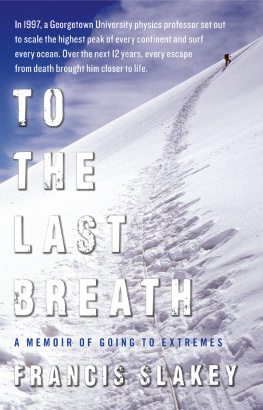ADVENTURES IN
HUMAN BEING
GAVIN FRANCIS is a GP, and the author of True North: Travels in Arctic Europe, and Empire Antarctica: Ice, Silence & Emperor Penguins, which won the Scottish Book of the Year Award and was shortlisted for the Ondaatje and Costa Prizes. He contributes to the London Review of Books, Guardian, and New York Review of Books, and lives in Edinburgh.
ALSO BY GAVIN FRANCIS
True North: Travels in Arctic Europe
Empire Antarctica: Ice, Silence & Emperor Penguins
ADVENTURES IN
HUMAN BEING
GAVIN FRANCIS

First published in Great Britain in 2015 by
PROFILE BOOKS LTD
3 Holford Yard
Bevin Way
London
WC1X 9HD
www.profilebooks.com
Published in association with Wellcome Collection

Wellcome Collection
183 Euston Road
London NW1 2BE
www.wellcomecollection.org
Copyright Gavin Francis, 2015
The moral right of the author has been asserted.
All rights reserved. Without limiting the rights under copyright reserved above, no part of this publication may be reproduced, stored or introduced into a retrieval system, or transmitted, in any form or by any means (electronic, mechanical, photocopying, recording or otherwise), without the prior written permission of both the copyright owner and the publisher of this book.
A CIP catalogue record for this book is available from the British Library.
eISBN 978 1 78283 104 4
That thrice-worthy Mercury calls man a great Miracle, a Creature like the Creator, the Ambassador of the Gods. Pythagoras the Measure of all things. Plato the wonder of Wonders All men with one consent, call him Microcosmos or, The Little World. For his body is, as it were, a Magazine or Store-house of all the virtues and efficacies of all bodies, and his soul is the power and force of all living and sensible things.
Helkiah Crooke, introduction to Microcosmographia (1615)
for lifes enthusiasts
A note on confidentiality
THIS BOOK IS A SERIES OF STORIES about the body in sickness and in health, in living and dying. Just as physicians must honour the privileged access they have to our bodies, they must honour the trust with which we share our stories. Even as long as two and a half thousand years ago that obligation was recognised: the Hippocratic Oath insists whatsoever in the course of practice you see or hear that ought never to be published abroad, you will not divulge. As a doctor who is also a writer Ive spent a great deal of time deliberating over that use of ought, considering what can and cannot be said without betraying the confidence of my patients.
The reflections that follow are grounded in my clinical experience, but the patients in them have been so disguised as to be unrecognisable any similarities that remain are coincidental. Protecting confidences is an essential part of what I do: confidence means with faith we are all patients sooner or later; we all want faith that well be heard, and that our privacy will be respected.
Prologue
If a man is made of earth, water, air and fire, so is this body of the earth; if man has in him a lake of blood the body of the earth has its ocean, which similarly rises and falls.
Leonardo da Vinci
AS A CHILD I didnt want to be a doctor, I wanted to be a geographer. Maps and atlases were a way of exploring the world through images that revealed what was hidden in the landscape, and were also of practical use. I didnt want to spend my working life in a lab or a library I wanted to use maps to explore life and lifes possibilities. I imagined that by understanding how the planet was put together Id reach a greater appreciation of humanitys place in it, as well as a skill that might earn me a living.
As I grew older that impulse shifted from mapping the world around to the one we carry within; I traded my geographical atlas for an atlas of anatomy. The two didnt seem so different at first; branching diagrams of blue veins, red arteries and yellow nerves reminded me of the coloured rivers, A-roads and B-roads of my first atlas. There were other similarities: both books reduced the fabulous complexity of the natural world to something comprehensible something that could be mastered.
The earliest anatomists saw a natural correlation between the human body and the planet that sustains us; the body was even a microcosm a miniature reflection of the cosmos. The structure of the body mirrored the structure of the earth; the four humours of the body mirrored the four elements of matter. There is sense to this: we are supported by a skeleton of calcium salts, chemically similar to chalk and limestone. Rivers of blood wash into the broad deltas of our hearts. The contours of the skin resemble the rolling surface of the land.
A love for geography never left me; as soon as the demands of medical training lessened I began to explore. Sometimes I found medical work as I travelled, but more often moved just to see each new place for myself to experience variety in landscapes and peoples, and become acquainted with as much of the planet as I could. When writing about those travels in other books, Ive tried to convey something of the insights those landscapes have given me, but my work has always brought me back to the body, as my means of making a living, and as the place from which all of us start and end. Learning about the human body is different to learning about anything else: you are the very object of attention, and working with the body has an immediacy and transformational power that is unique.
After medical school I intended to train in emergency medicine, but the brutality of the night shifts, and the fleeting contact with patients, began to erode my sense of satisfaction with the work. Ive taken jobs as a paediatrician, an obstetrician, and a physician on a long-stay geriatric ward. Ive been a trainee surgeon in orthopaedics and neurosurgery. In the Arctic and the Antarctic Ive been an expedition medic, and in Africa and India Ive worked in simple community clinics. These roles have all informed the way I understand the body: emergency situations are extreme and offer a heightened awareness of human lives at their most vulnerable, but over the years some of the deepest and most rewarding insights medicine has given me have been from quieter, everyday encounters. Latterly, Ive worked from a small, inner-city clinic as a family doctor.
Culture continually reshapes the ways we imagine and inhabit the body even as doctors. Through my encounters with patients Im often aware of how some of humanitys finest stories and greatest art have relevance to, and resonance with, modern medical practice. The chapters that follow look deeper into some of those connections.
Some examples: when assessing someone with paralysis of the face, Im reminded not just of the frustration of being unable to express oneself, but of the age-old difficulty artists have had in accurately portraying expression. When thinking about recovery from breast cancer, Ive been conscious that perspectives on what constitutes healing are different for each patient. Three-thousand-year-old texts like Homers Iliad can give insights about shoulder injuries, both ancient and modern, and the fairy tales we learned in the nursery eloquently explore ideas of illness, coma and transformation. The customs we bring to bear on our bodies are wonderfully diverse, something that struck me when thinking about the ways in which we dispose of the placenta and umbilical cord. Myths of struggle and redemption echo the convalescence stories going on in orthopaedic wards all over the world.
Next page

